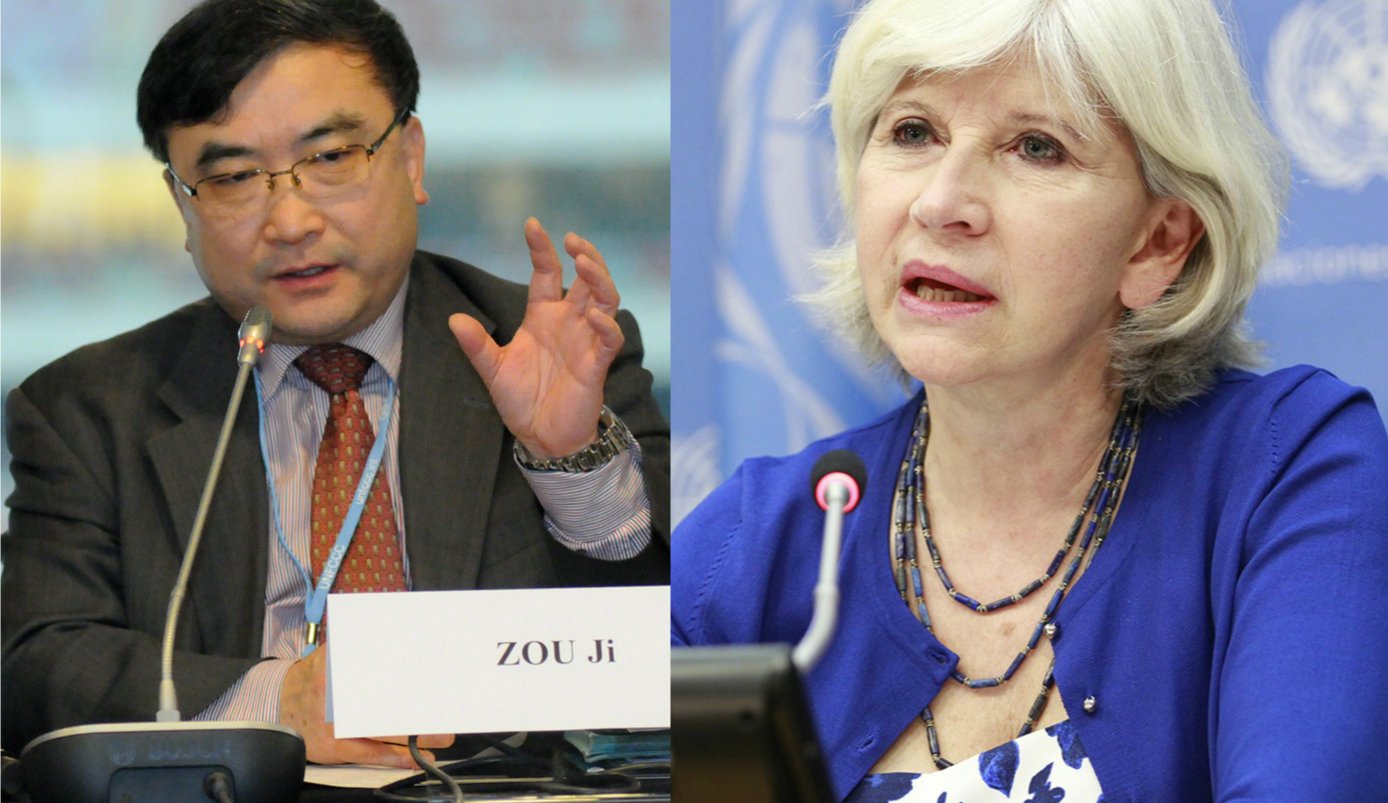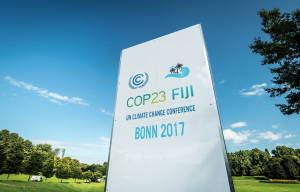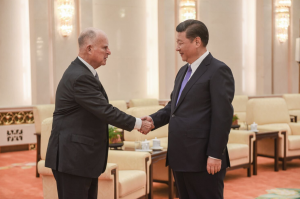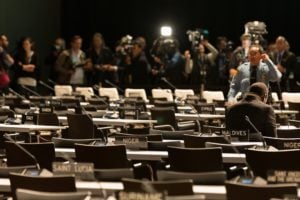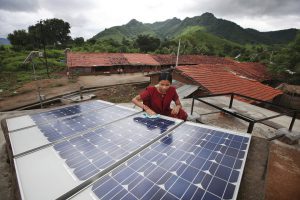Governments are convened in Bonn this week and next for the 2017 United Nations climate conference to discuss next steps on from the Paris Agreement in 2015. At this juncture, the key questions include: how far are we from reaching the emission reduction goals needed to cap global warming at 1.5 or 2 degrees Celsius above pre-industrial levels? How will the US withdrawal from the Paris Agreement impact this year’s talks? And are Europe and China ready to take the lead in raising ambitions among member states?
We talked to two prominent former climate negotiators from Europe and China: Laurence Tubiana, chief executive officer of the European Climate Foundation, and Professor Zou Ji, president of the Energy Foundation China. While climate action is moving forward without the US, the gap between goals and actions on the ground is still alarming.
chinadialogue (CD): Globally, how far are we from achieving the targets needed to keep the planet on a 1.5 or 2 degree Celsius pathway?
Laurence Tubiana (LT): We have to recognise that with all the contributions that have been presented we are still not on track to meet the global goals. We know that, for example, global emissions will not peak by 2030. The contributions that are on the table only meet a third to half of [the reductions] needed, at best. So there is a global gap.
CD: How would you assess the action of European members since the Paris Agreement was signed?
LT: Europe has to do more, particularly to reach the 2030 goals. There are signs that individual countries in Europe are taking more ambitious steps. France aims to end the sale of gasoline and diesel vehicles by 2040 and become carbon neutral by 2050, which goes beyond what has been decided at the European level.
Some countries have taken the decision to phase out coal by 2022 [for example, Italy]; and to reach zero emissions by 2040. Investment in energy efficiency is also critical. Countries like Sweden, Denmark, the UK and Germany are undertaking similar measures.
What I take from this is that every European country can make their national targets more ambitious compared to what is on the table for 2030. That is what needs to happen now.
That is not to say that we should revise the contributions, there is no consensus on that. But every country can take new steps, new plans and new decisions. I see good signs that countries beyond Europe are doing this as well.
CD: What impact will the US decision to withdraw have on this year’s talks? And what is the level of international pressure on China to fill the leadership void?
LT: With the US backtracking, each country is looking at what others are doing, particularly Europe and China, to see whether they are willing to do more. It is a joint responsibility. In Europe, every country would like to do more and we certainly wish that China can do the same.
The gap is there, we can’t deny that. And there is a common understanding that we need to make progress. So the pressure is on everyone. The Chinese government recognises this. I don’t think the pressure is on China alone, this is a joint movement.
President Xi has repeatedly mentioned China’s role in global leadership recently. There are positive signs that China is already taking steps beyond its nationally determined contributions. There are encouraging elements in its coal policy, on its zero-emission car policy, and on green finance.
Zou Ji (ZJ): All parties’ responsibilities, including the EU and China’s, were defined very clearly in the Paris Agreement. This is the fundamental basis [for moving forward]. I don’t see any change resulting from President Trump’s decision to withdraw.
To link China with the international community, we have so much to do and to show in playing our role. It is important to link global climate concerns with local environmental concerns, especially around air quality. I must emphasise that aims around economic upgrades, energy transformation, local air quality and global climate concerns are consistent with each other. That is why China is confident in saying, ‘this is our business’.
We also saw a milestone reached in the 2035 goal according to the message conveyed at the 19th Party Congress. [During the 2017 Chinese Communist Party Congress Environment Minister Li Ganjie vowed that “by 2035 there will be a fundamental improvement in the environment, and the goal of building a ‘Beautiful China’ will basically be attained”.] If international promises are not acted upon domestically, [China] cannot say that it plays the role of leader.
Pathways are needed to link long-term, mid-term and short-term goals. Targets, policies, and institutional arrangements are required at different levels. Other aspects include economic restructuring based on high efficiency for growth and a transition to sustainable energy systems.
China now has a clearer roadmap for its technology sector. But the uptake of technology requires adoption by stakeholders, financiers, investors, enterprises, consumers, local governments and central government. That is why policy and institutional arrangements are critical to changing behavior and motivation.
CD: There are voices from Europe saying that the EU and China are joining forces to forge ahead on the implementation of the Paris Agreement and accelerate the global transition to clean energy. Do you think there is an “EU-China climate alliance”?
LT: Trade is an important concern for both sides, and will continue to be in the future, which is normal. It is good to have global competition around green technology.
On the other side, you see two markets beginning to become very closely linked. There are big developments in China concerning green technology. Other than solar panels, there are manufacturing sectors, such as electric vehicles, where the EU and China are working closely side-by-side.
There was so much attention on the US-China relationship. The EU-China alliance is something more technical, more diplomatic, but not as substantive. A lot of bilateral discussions are needed, between Germany and China, France and China, UK and China, and so on, to make climate part of a broader discussion, for example, an economic discussion.
We need this discussion at all levels to move forward. With the United States administration absent from climate discussions, we need more high level dialogue.
It is already taking place. China, together with Europe and Canada, has invited major economies to form climate forums to fill the gap [left by the US]. The world has seen the political necessity of cooperation – it has not been contradicted by competition.
ZJ: If we judge [a country’s share of] responsibility based on its domestic implementation, undoubtedly, China and EU are the two major players. China is taking responsibility as a large developing country, while the EU does so as a group of developed economies. Besides multilateral cooperation, we should explore how to optimise our roles at a bilateral level.
We used to take the China-US relationship as the most important bilateral relationship but we should not forget that the China-EU relationship is also critical. Not only in a bilateral sense, but in a global sense. China and the EU have cooperated on trade, investment, technology and so on in recent years to implement the Paris Agreement.
The two parties have formed joint working groups to establish a regular mechanism for delivery. I myself and Madame Laurence have experienced that kind of cooperation directly, both on the governmental level and non-governmental level, with enterprises and academics. We have the same goals: sustainable development, low-carbon transition, but a different status.
Having said that, we should think about the future. I still see room for both sides to explore, deepen and enlarge this cooperation. One of the platforms on which to do this, of course, is the Belt and Road Initiative.
CD: China’s climate leadership is a complicated matter. On one hand, China is the world leader in renewable energy, and runs a South-South climate alliance outside of the UNFCCC system. But on the other, Chinese companies are building new coal power plants overseas. How should we understand China’s role in global climate action?
ZJ: We should make our overseas investments green and low carbon, this is the basic principle. But when we look at specific contexts – take Southeast Asia, for example, which is rich in coal – the question is can we say that we will not support coal power plants, like the guidelines of OECD countries and the World Bank? Can you stop countries from building new coal power plants? My answer is no. And then what happens? Without technical and financial support, countries will build highly polluting, inefficient and small-sized coal power plants.
We should make our overseas investments green and low carbon
One solution is to set up environmental standards for coal power plants. But this is not the final solution, as carbon emission cannot be reduced on a large-scale this way. Nowadays, hydro power, which is a rich [resource] in these countries, is under consideration. The international community should provide support for the energy transition to make coal the last priority.
LT: It is important for China to offer investment and infrastructure to other developing countries. Making the Belt and Road Initiative greener is something which we would like to work on together. How to introduce the principle of green development to the Belt and Road Initiative would be a very promising avenue. At least at the academic level, we can certainly develop the thinking.
Europe is very interested in greening the Belt and Road Initiative to encourage countries to move away from coal. That would certainly be one of the cooperation areas.
Edited from the original transcript.
